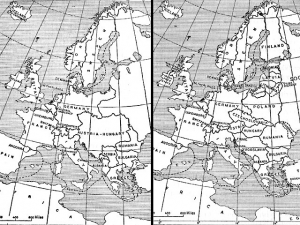Political Change After The Great War
All the protaganists of World War One fought to gain national security and independent territories, based on religious and ethnic integrity. But the political fault lines of the pre-war years continued into the post-war years, leading ultimately and inevitably to the Second World War.
The Great War saw the sudden implosion of four empires; The German Empire, The Hapsburgs, The Ottoman Empire and The Romanov Empire. In 1918, only the constitutional monarchy of Great Britain survived, a unique institution of Government, exercising influence but no power. Once hostilities had commenced in 1914, the European monarchs played ever-deminishing roles in their countries’ affairs. By contrast, military elites wielded power and survived the war, and after it that power only increased.
In Germany, war planning began the day the treaty of Versailles was signed. The general staff remained a dominant force throughout the Weimar period, its status and prestige enhanced by Hitler. The right wing Junker class also survived along with the german Social Democrats.
France continued to decline in the post-war years; the French birth rate continued to fall and the nation’s governments were short-lived and just as fractious and chaotic as in the decade preceeding the conflict. France continued to fear Germany.
Britain never fully recovered financially from the First World War. Her pre-war economic decline continued throughout the 1920s and ’30s. She could no longer hold “the Balance of Power” in Europe. Italy and Japan remained dissatisfied with the Versailles settlement, hence Italy’s imperialist policies in Libya and Ethiopia, and Japan’s aggression against China and Malaysia.
The destruction of the Hapsburg monarchy created a plethora of ethnically divided territories in Eastern Europe. America quickly retreated into her traditional isolationalist stance, distrusting the imperial pretensions of “the old world” and refusing to support the League of Nations.
In the Middle East, the last gasp of European Imperialism was played out, the French and British creating nations with artificial frontiers, such as Syria, Iraq, Jordan, Palestine and Lebanon. This left Arabs and Jews dissatisfied by the quite incompatible terms of the Sykes-Picot Agreement of 1916, and the Balfour Declaration the following year. Together, they promised both Jew and Arab alike independent autonomy in Palestine – the effects of which are still with us to this day.
Only in Russia was there a clear break from the past. The fall of the Romanov’s exchanged an ineffective, bureaucratic tyranny for a ruthless a ruthless, efficient, ideological dictatorship, which exterminated the aristocracy and middle classes, establishing a messianic, secular religion as a government.
In summary, the First World War accelerated the established trends of the pre-war years, but without solving the problems of social class ethnicity and chronic insecurity felt in world politics circa 1913.
